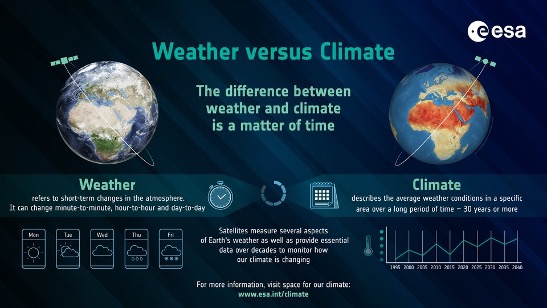Sustainable Times
The ‘weather’ and ‘climate’ are often used to mean the same thing but are actually very different and by mixing them together it is easy to overlook the story they tell.
Weather is the short-term weather that we experience day to day. Take a look outside your window right now and if it is raining, windy, dry or sunny, that is the weather. Climate on the other hand is what Is happening long term, think decades rather than months or years.
So weather is the right now and climate is the trend, take a look at the diagram above (© esa www.esa.int/climate Comparing the weather tells us very little about global warming and ‘climate change’. That is why it is very misleading to try and compare the weather now with what we have had in the past. It is easy to say ‘What is all the fuss about? Sure, we are experiencing a heat wave right now, but I remember the summer of 1976. Relax, stop complaining and enjoy the sun’.
It is only when we look at the climate that we begin to see the real story. Imagine trying to understand the plot of a film by watching it for 3 minutes near the beginning of the film and another 3 minutes near the end. While you see what is happening it probably won’t make sense and you will not understand the story it tells. Only by watching the whole film will you understand what it is all about.
That is why it is more important to look at what the climate is doing rather than the weather.
The weather will always vary and there will be the hot year, the year it didn’t rain for months, and the year the airport road flooded. On their own it is not too much to be worried about unless they are happening more often, getting more extreme or
happening in places they didn’t before (they are)
That is what the climate tells us. So, when the climate shows that temperatures are rising, even if it is by a degree or two it is a worrying sign.
Our planet usually does a great job of looking after itself and not everything that happens can be blamed on humans. However, it is also a fragile eco-system and there is only so much it can handle.
So why are humans mostly to blame? Well if we think that ‘modern’ humans have been around for 100,000 years. We only started to really farm around 10,000 years ago and we have been considered a civilisation (think complex society) for around 5000 years. In the year 1000 the world population was around 300 million, 500 years later in 1500 it was around 500 million. We hit the 1 billion mark around 300 years later in the 1800s and then 2 billion about 100 years later around 1900. By 1950 the figure is 2.5 billion, just 9 years later it hit 3, and then 4 billion around 1974. It took another 13 years to hit 5 billion, 12 more to hit 6, and another 12 to hit 7 billion around 2012.
So going back to the year 1000 it took us 800 years to go from 300 million people on the planet to 1 billion. It has then taken us just a little over 200 years to go from 1 billion to 7 billion. We are now adding a billion people every 12 years, and it will get even quicker.
Millions and Billions are so easily thrown around these days that it can be easy to forget how different the numbers are. So lets put them into a context that is easy to imagine. 1 Million seconds is 12 days, 1 Billion seconds is 31 YEARS. Just think about that. And if you want to get really crazy (considering we have just seen our first companies valued at 1 Trillion dollars), 1 Trillion seconds is over 31,000 years.
Hopefully it is now a lot easier to appreciate that our planet does not have a chance to continue repairing the damage us humans are doing to it and why we must change our ways. It is simply not sustainable, we need sustainable times.


